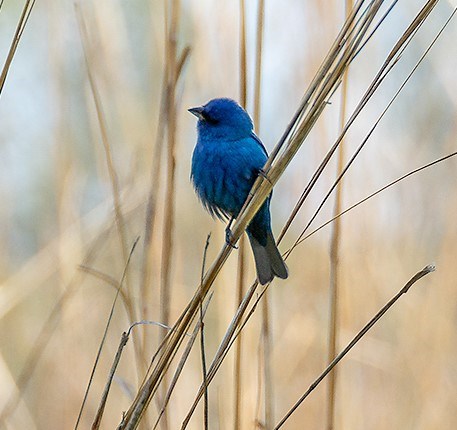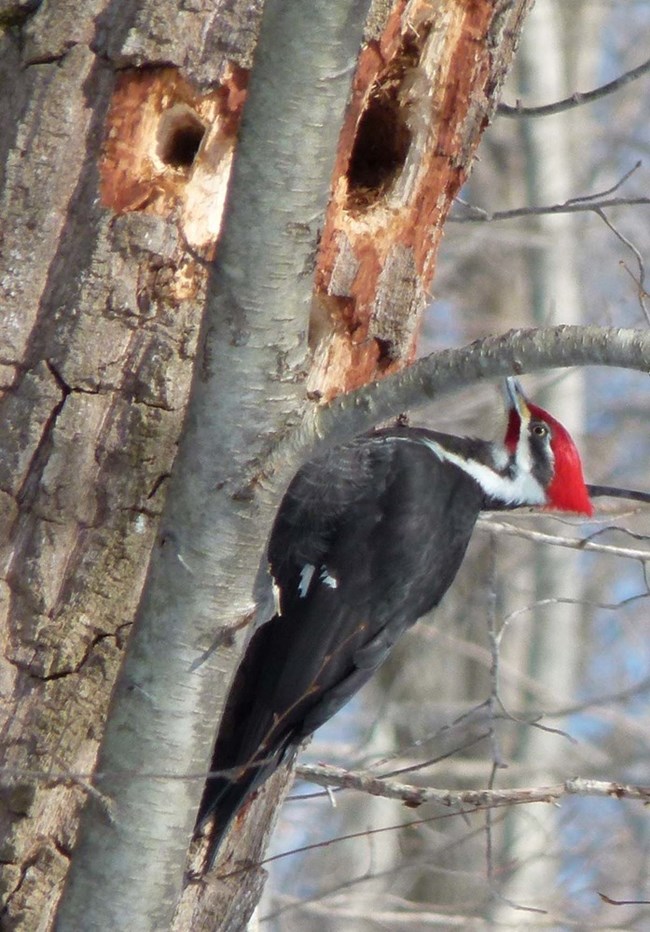
Volunteer John Zuke Catoctin Mountain Park Avian Inventory (doc 524kb) 
NPS Photo Woodpeckers start to set up home territories in March and will advertise their possession of a territory by drumming. Different species of woodpecker can be told apart by their drumming patterns and volume. There are seven species of woodpecker found in Catoctin Mountain Park. There are 45 species in the U.S. and 200 species found worldwide. Picidae, the woodpecker family, fills a unique niche in the bird world; they drill into trees to eat the insects found in wood. They have some very specific adaptations to be able to do this. They have strong, sharp beaks, strong neck muscles, bristly feathers that keep wood dust and chips out of their nostrils, a padded brain, and many have a long tongue that can impale insect larvae in order to extract them from holes. This long tongue often wraps around inside the back of the skull when retracted. The retracted tongue acts as extra cushioning for the brain. Other tree-climbing adaptations include clawed feet, most species have two toes pointed forward and two toes pointed backward, and stiff, pointed tail feathers that catch on bark to help stabilize the birds while hammering. Common woodpeckers that can be seen are downy, hairy, and red-bellied woodpeckers. In extensive wooded areas with large trees, piletaed woodpeckers may also be present. Flickers are a common species in this area. Less common woodpeckers include red-headed woodpeckers and yellow-bellied sapsuckers. Sapsuckers have an interesting habit of pecking rows of holes in trees. They return to these holes to feed on the sap, and the insects that are drawn to the sap. These holes are shallow, and rarely damage the tree. Woodpeckers eat primarily wood-boring grubs, insects, insect eggs and pupae. They also consume nuts, fruit, and sap from trees. Woodpeckers have an undulating flight caused by their four to five flap, then pause flight pattern. Other signs of woodpeckers include the sound of tree-tapping and the presence of wood chips at the base of trees. Winter is a good time of year to watch woodpeckers. They are more visible in leafless trees and their hammering and calls carry well through the still woods.
Regional Bird Monitoring
Since 2007, the National Capital Region Network (NCRN) Inventory & Monitoring program has monitored birds at approximately 385 forest plots throughout the region. This program represents one of the many ways national parks use science to manage our national treasures. Top 10 Most Common Birds at Catoctin Mountain Park
What’s impressive about this top ten list is that it includes a species of conservation concern. The Wood Thrush is designated as a “watchlist species” by the Partners in Flight program. The fact that it makes Catoctin’s top ten list means that this vulnerable species is finding valuable habitat at Catoctin. Common Birds in Catoctin Mountain Park The following list does not represent all of the birds found in the park: only those reported by the NCRN Inventory & Monitoring. Birdwatchers are likely to see many other species depending on migration patterns. From 2007 to 2010, the number of different species detected each year at Catoctin ranged from 41 to 59. Catoctin is home to 13 species of conservation concern, marked below with asterisks.
*Partners in Flight Watchlist species are vulnerable at a continental scale **Stewardship Species have most of their global population within the region. +Detections of Carolina and Blackcapped Chickadee are combined
| |||||||||||||||||||||||||||||||||||||||||||||||||||||||||||||||||
Last updated: March 16, 2021
